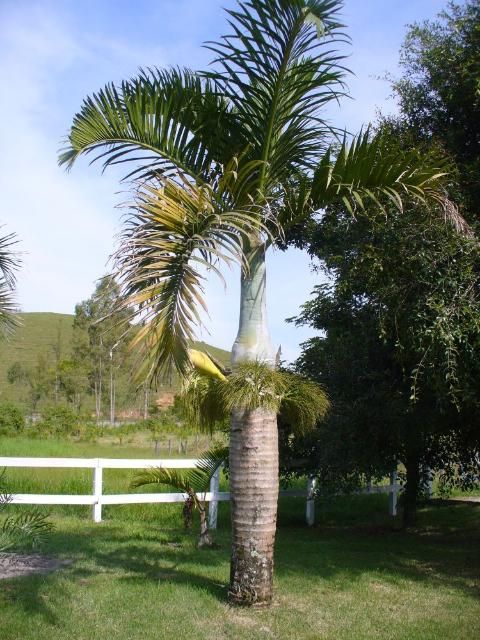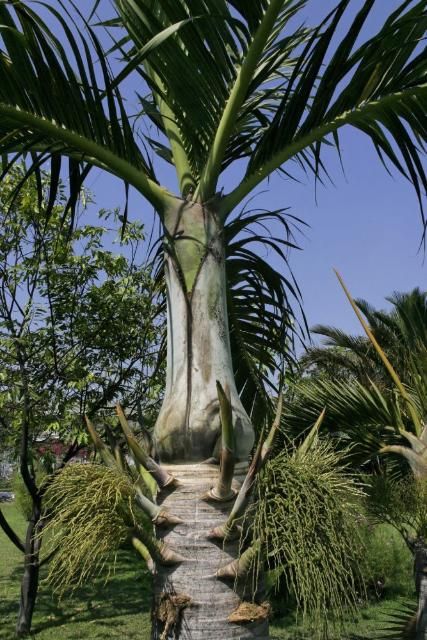Family
Arecaceae, palm family.
Genus
Hyophorbe is a combination of two Greek words: hyo meaning "pig, hog" and phorb, meaning "feed, fodder." The name is thought to come from the use of the palm's fruit for pig fodder.
Species
The species name, verschaffeltii, is the Latinized surname of Ambroise Verschaffelt, a Belgian nurseryman of the 19th century for whom this palm is named.
Common Name
Spindle Palm
The common name of this palm refers to the spindle-shaped stem, which tends to gradually widen above the base and then re-constrict in the crownshaft.
Description
This palm is endemic to the Mascarene Islands, which are located to the east of Madagascar in the Indian Ocean. The palm naturally inhabits the well-drained sandy soils of upland forests and coastal savannas. In the United States, this palm grows in south Florida, extreme southern California, and the Hawaiian Islands. This slow-growing tree can reach heights that range from 20 to 25 feet, growing best in full sunlight. The pinnately compound leaves or fronds can grow from 6 to 10 feet long and are attached to a petiole that can extend nearly one foot long. Its lance-shaped leaflets are dark green, approximately 2 ½ feet long, and grow out of the rachis at different angles, giving the leaf a feathery look. The trunk is light gray, has rings around it, and is most swollen at the midpoint of its total height. On top of the trunk sits a bright green crownshaft (from which the fronds emerge) that has a smooth, waxy surface and can reach 2 to 3 feet in height. The base of the crownshaft tapers from the swollen part of the trunk and becomes more slender as it elongates to the top of the palm. Inflorescences can reach lengths of 2½ feet, are heavily branched, and encircle the trunk just below the crownshaft. Male and female flowers occur on the same inflorescence and are white or cream colored. Each fruit is 3/4 inch in diameter and turns from orange to red as it ripens.

Credit: Scott Zona, (CC BY 2.0)

Credit: Tony Rodd, (CC BY-NC-SA 2.0)
Applications
Horticultural
The trunk of this palm is somewhat unusual, since its widest diameter occurs mid-length. It can be planted as a singular palm or blended with other palms on the landscape. Spindle palm grows best in full sun and requires irrigation during dry periods. Like the bottle palm (Hyophorbe lagenicaulis), it is sensitive to freezing temperatures. However, the spindle palm is somewhat tolerant of freezing temperatures and more likely to survive them than the bottle palm. This species is susceptible to lethal yellowing disease (https://edis.ifas.ufl.edu/pp146), so it is best to avoid planting the spindle palm where the disease is known to occur. This palm may also be deficient in potassium and magnesium and, therefore, it may be necessary to provide additional nutrient supplements. Spindle palm makes an attractive indoor plant and will do well as long as enough light and space are available. Although it is cultivated and planted worldwide, in its natural range spindle palm is critically endangered, almost to the point of extinction.
References
Borror, D. J. 1988. Dictionary of root words and combining forms (2nd ed.). Mountain View, CA: Mayfield Publishing Company.
Floridata.com. 1999. Hyophorbe verschaffeltii, Retrieved from http://www.floridata.com/ref/h/hyop_ver.cfm
Harrison, N. A. and M. L. Elliot. 2009. Lethal yellowing (LY) of palm (PP146). Gainesville, FL: UF-IFAS Florida Cooperative Extension Service. Retrieved from https://edis.ifas.ufl.edu/pp146
Meerow, A. W. 2004. Betrock's guide to landscape palms (9th ed.). Hollywood, FL: Betrock Information Systems.
Riffle, R. L. and P. Craft. 2003. An encyclopedia of cultivated palms. Portland, OR: Timber Press, Inc.